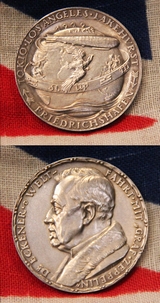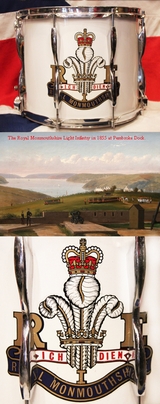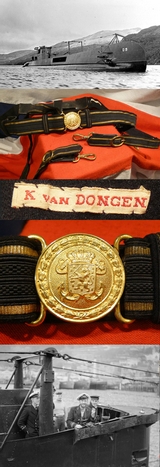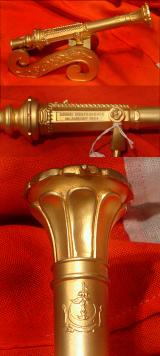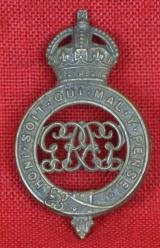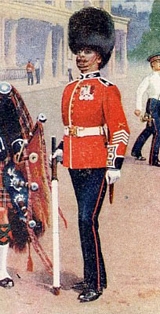WW1 / WW2 / 20th Century
A Rare Karl Goetz Silver Zeppelin World Circumnavigation Medal of 1929
A Rare Karl Goetz Zeppelin Medal. Silver medal of 1929, for circumnavigation of the world, in the airship LZ 127. Half-length portrait of the air pioneer and airship leader Hugo Eckener. Aircraft and flying eagle in front of globe, around the globe a band with star signs. With a punch: BAYER. MAIN COIN OFFICE ? FINE SILVER. 59.98 mm; 54.37 g. Matt finish, very pretty patina, small edge error, almost uncirculated read more
425.00 GBP
A Unique 'Sealed Pattern' Cap Badge of the Fusilier Brigade 16.9 1966
Inspectorate of Stores and Clothing . Since the early XVIII Century, it was common practice for all European armies to approve items of clothing and accoutrements for each regiment in a formal session of the appropriate War Office `Dress Committee`.
At these sessions, an example of each item would be deposited with the Committee, signed, sealed and certified as being the `Sealed Pattern`, against which all items worn in future would be compared. At future inspections of each regiment, any item showing variations from the norm would be amended or scrapped. since the start of the eighteenth century a band of officers of the British Army (or other responsible persons) has approved the quality and finish of all items of military clothing, it was then sealed with the wax of the Board of Ordnance or other Government seal to be recognised as the standard to be kept by the manufacturers. There is valuable evidence to be seen on these patterns because they also carry the date of approval and obsolescence of each item. Unfortunately, that system has not proved to be infallible. In 1841, all sealed patterns accumulated since the beginning of the eighteenth century, were destroyed in a fire at the Tower of London. No secondary store existed and thus all patterns encompassing Marlborough?s campaigns, the Seven Years War, the American War of Independence and the Napoleonic Wars were lost. read more
195.00 GBP
A Rare and Original British WW2 'Concealment' Instructional Poster for The Camouflage Officer
Original British Army poster. With four fold creases and a little staining. 19 inches x 24 inches read more
195.00 GBP
ERII Drum of the Royal Monmouthsire Royal Engineers Regiment.
An ERII, post 1954 drum of a Welsh Royal Engineers regiment. The Royal Monmouthshire. Top skin needs replacing. A most attractive piece of British Military History. The Royal Monmouthshire Royal Engineers (Militia) (R MON RE(M)) is the most senior regiment in the British Army Reserve, having given continuous loyal service to the crown since 1539. It is part of the reserve forces, and is the only remaining Militia unit in the British Army. The regiment is also unusual in having the word Royal appear twice in its name. It gained the first "Royal" in 1804 when it was known as the Monmouth and Brecon Militia. The second was acquired in 1877 when the regiment transferred from an infantry unit into a Special Reserve section of the expanding Royal Engineers. The top skin in split and would need replacing if it was required to be used as a drum once more. read more
575.00 GBP
An Excellent WW2 Free Dutch Navy, Royal Netherland Navy Submarine Captain's Dress Belt 1930's Used in WW2
The service dress belt of a RNN submarine commander of the Royal Netherlands 'Free' Navy of WW2. Commander of a RNN U Boat, the Free Dutch Navy Submarine of WW2 HNLMS O 19 (N 54). Capt. Van Dongen. Luitenant ter zee 1e klasse (Lt.Cdr.) Karel van Dongen, RNN 0 19, 3 Jul 1939 till 31 May 1941. On 10 May 1940, the day the Germans invaded the Netherlands, the entire mobilization was proclaimed in the Dutch colony. Most Dutch warships, including the O 19, were used to protect allied merchant ships and to patrol the Indonesian archipelago.
The submarine performed multiple patrols and missions in the Pacific theater of World War II, sinking multiple Japanese vessels, attacking shipping convoys and laying mines.
On 8 July 1945, O 19 was en route to Subic Bay in the Philippines at a speed of 16 knots (30 km/h; 18 mph) when it struck Ladd Reef in the South China Sea. Unable to pull free of the reef, the crew of O 19 were rescued by USS Cod. To prevent enemy capture, O 19 was scuttled by her crew using explosives, torpedoes and gunfire An example of the of the calibre of WW2 serving officers who were awarded such a highly respected decoration was the heroic Canadian born, Royal Air Force fighter pilot ace RUSSEL, F/O Blair Dalzell, DSO, DFC (C1319) -
Officer, Order of Orange-Nassau with Swords (Netherlands)
Awarded as per London Gazette dated 23 January 1948 and
AFRO 81/48 dated 6 February 1948.
Public Records Office Air 2/9293 has recommendation drafted when he was a Wing Commander: In operational command of No.126 Wing, Royal Air Force, stationed at the aerodrome Volkel from September 1944 until February until April 1945, through his excellent work has greatly contributed to the liberation of the Netherlands. During World War II, the Order of Orange-Nassau was bestowed upon both members of the Netherlands military and members of foreign services who had helped liberate the Netherlands from Nazi Germany occupation, and those who helped liberate the former Dutch colonies in the Pacific. In the modern age, the Orange-Nassau is still the most active military and civil decoration of the Netherlands, and ranks after the Order of the Netherlands Lion. The Order is typically awarded each year on the Queen's official birthday (April 30) The Order is also used to honour foreign princes, ministers, dignitaries and diplomats.
The Dutch Navy at the beginning of the war with Germany in May 1940, consisted of 1 coastal defence ship, 5 cruisers, 9 destroyers, 27 submarines, 4 gun boats, 6 minelayers and other smaller vessels. The Dutch Navy fought in many parts of sea like North Sea, Mediterranean and the Pacific sea where the Dutch navy had to defend the Dutch colonies from the Japanese advance.
Dutch naval forces had a contribution of sinking many enemy vessels, including 2 U-boats and also Japanese and even Italian submarines. But they also suffered many losses during the war, especially their submarine arm. They lost the coastal defence ship Soerabaja, the 3 cruisers De Ruyter, Java and Sumatra, 9 destroyers, 11 submarines and other smaller vessels. According to records the Royal Dutch Navy lost 59 warships during WWII [40%] Awarded to the Commander of a RNN U Boat, the Free Dutch Navy Submarine of WW2 HNMS O 19 (N 54)
Navy The Royal Dutch Navy
Type Submarine
Class O 19
Pennant N 54
Built by Wilton-Feijenoord (Schiedam, Holland)
Ordered
Laid down 15 Jun 1936
Launched 22 Sep 1938
Commissioned 3 Jul 1939
Lost 10 Jul 1945
Loss position 8? 40'N, 111? 40'E. We also havehis service medal group, for sale seperately read more
225.00 GBP
A Solid Gilt Bronze, Beautiful, Independence of Brunei 1984 Desk Cannon
In fine deluxe gilt finish, a modern representation of a an early Lantaka Cannon and Carriage, bearing the Royal Crest of the Sultan of Brunei. Especially commissioned for the Independence of Brunei in January 1984. Brunei, officially the Nation of Brunei, the Abode of Peace, it is a country located on the north coast of the island of Borneo in Southeast Asia. Apart from its coastline with the South China Sea, the country is completely surrounded by the insular Malaysian state of Sarawak. It is separated into two parts by the Sarawak district of Limbang. Brunei is the only sovereign state completely on the island of Borneo; the remainder of the island's territory is divided between the nations of Malaysia and Indonesia.. The government is an absolute monarchy under the Sultan, which implements a combination of English common law and sharia law, as well as direct general Islamic practices.
At the peak of the Bruneian Empire, Sultan Bolkiah (reigned 1485–1528) is alleged to have had control over most regions of Borneo, including modern-day Sarawak and Sabah, as well as the Sulu Archipelago off the northeast tip of Borneo, Seludong (modern-day Manila), and the islands off the northwest tip of Borneo. The maritime state was visited by Spain's Magellan Expedition in 1521 and fought against Spain in the 1578 Castilian War.
During the 19th century, the Bruneian Empire began to decline. The Sultanate ceded Sarawak (Kuching) to James Brooke and installed him as the White Rajah, and it ceded Sabah to the British North Borneo Chartered Company. In 1888, Brunei became a British protectorate and was assigned a British resident as colonial manager in 1906. After the Japanese occupation during World War II, in 1959 a new constitution was written. In 1962, a small armed rebellion against the monarchy was ended with the help of the British.
Brunei gained its independence from the United Kingdom on 1 January 1984. 28cm long read more
295.00 GBP
A King George Vth Die Struck Grenadier Guards Pagri Badge
The front has lost its gilt wash due to polishing, the rear has it remaining.The Regiment, as the Royal Regiment of Foot Guards, was formed in 1656 by King Charles the Second who was then in exile in Bruges, Flanders. It was known as the First Guards, later becoming the First Regiment of Foot Guards, and now bears the title "The First or Grenadier Regiment of Foot Guards" in honour or the defeat of the Grenadiers of the French Imperial Guard at the Battle of Waterloo in 1815.
It is the only Regiment in the British Army that has directly gained it's title from the part it played in action. As seen in all of Her Majesty The Queen's ceremonial occasions, such as Changing of The Guard and Trooping the Colour. read more
35.00 GBP
A Most Rare Large Aviation Medal For the Acceptance Run of the 'LZ 4'.Zeppelin
Medal 1908, by A. Galambos. On the acceptance run of the 'LZ 4'. Germania with sword in the right wreath medallion of Count Zeppelin under oak, right a crowd of faces in an auditorium and an airship above / winged male figure with torn chain over globe and cloud. Kaiser 292.3, Gutt 14
Obverse — Goddess Germania with Sword in right hand. 60 mm. They made a smaller 33 mm silver version, and a small undated bronze version 33mm but this is the very rare, large gilt bronze version, of 60mm
Dir/ Danken/ Deine/ Deutschen.
A. Galambos on bottom
inscription — 4. 5. August 1908 on the left. A. Galambos. The Zeppelin LZ 4 was a German experimental airship constructed under the direction of Ferdinand von Zeppelin. First flown on 20 June 1908, it made a series of successful flights including a 12-hour flight over Switzerland. It was destroyed when it caught fire after landing to carry out engine repairs during a projected 24-hour endurance trial.This disaster proved fortunate for Zeppelin: donations by the German public raised 6.5 million marks, so guaranteeing the future of his development of airships. . At Westfälische Auktionsgesellschaft
Auction 71, 29-30 April 2014, a much smaller silver more common version of this medal sold for 480 euro. read more
450.00 GBP
A Very Good Pre WW1 Royal Engineer's Dress Uniform for Lance Corporal
Tunic and trousers. In excellent condition for age. Fine red cloth with single bullion corporal stripe . Fine original Royal Engineer buttons. Austrian knots and cuffs. British other ranks and NCO's uniforms made prior to WW1 are very sought after and so few survive today as to make them most scarce and very interesting. Makers label inside with date. read more
495.00 GBP
A Most Scarce WW1 Scot's Guardsman's Tunic, Part of The British Monarch’s Personal Guard
Tunic in traditional red with brass buttons. The centre regiment of the five Guards Regiments of the Household Div. The Scots Guards have over three hundred and sixty years of unbroken service to the crown. They can trace their origins back to an army that was raised by Archibald 1st Marquess of Argyll, 16 March 1642. Since this date the Regiment has served in nearly every campaign in which the British Army has been involved in. In 1686 they were brought onto the establishment of the English Army for the first time. Eight years later they took precedence within the Foot Guards, despite their seniority by length of service. The Battle Honours of the Regiment are;
Namur 1695, Dettingen, Lincelles, [Egypt]1, Talavera, Barrosa, Fuentes d?Onor, Salamanca, Nive, Peninsula, Waterloo, Alma, Inkerman, Sevastopol, Tel-el-Kebir, Egypt 1882, Suakin 1885, Modder River, South Africa 1899-1902
First World War: Retreat from Mons, Marne 1914, Aisne 1914, Ypres 1914 ?17, Langemarck 1914, Gheluvelt, Nonne Bosschen, Givenchy 1914, Neuve Chapelle, Aubers, Festubert 1915, Loos, Somme 1916 ?18, Flers-Courcelette, Morval, Pilckem, Poelcappelle, Passchendaele, Cambrai 1917 ?18, St. Quentin, Albert 1918, Bapaume 1918, Arras 1918, Drocourt-Qu?ant, Hindenburg Line, Havrincourt, Canal du Nord, Selle, Sambre, France and Flanders 1914-18
Second World War: Stien, Norway 1940, Mont Pincon, Quarry Hill, Estry, Venlo Pocket, Rhineland, Reichswald, Cleve, Moyland, Hochwald, Rhine, Lingen, Uelzen, North-West Europe 1944-45, Halfaya 1941, Sidi Suleiman, Tobruk 1941, Gazala, Knightsbridge, Defence of Alamein Line, Medenine, Tadjera Khir, Medjez Plain, Grich el Oued, Dejbel Bou Aoukaz 1943 I, North Africa 1941-43, Salerno, Battipaglia, Volturno Crossing, Roccheta e Croce, Monte Camino, Anzio, Campoleone, Carroceto, Trasimene Line, Advance to Florence, Monte San Michele, Catarelto Ridge, Argenta Gap, Italy 1943-45
Honours since the Second World War;
Tumbledown Mountain, Falkland Islands 1982, Gulf 1991 read more
465.00 GBP


